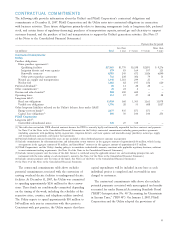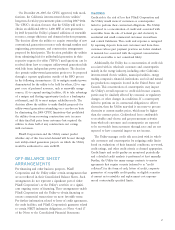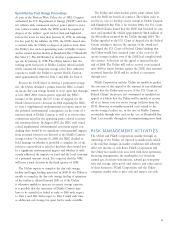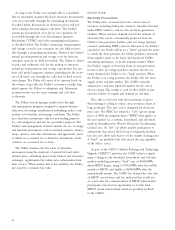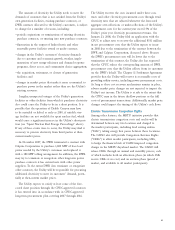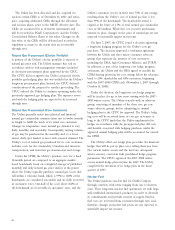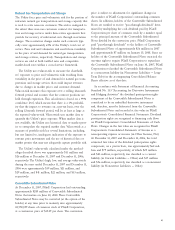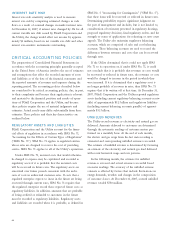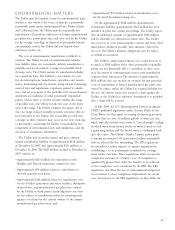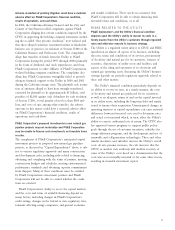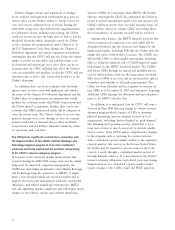PG&E 2007 Annual Report Download - page 65
Download and view the complete annual report
Please find page 65 of the 2007 PG&E annual report below. You can navigate through the pages in the report by either clicking on the pages listed below, or by using the keyword search tool below to find specific information within the annual report.63
Natural Gas Transportation and Storage
The Utility faces price and volumetric risk for the portion of
intrastate natural gas transportation and storage capacity that
is used to serve non-core customers. This risk is mitigated to
the extent these non-core customers contract for transporta-
tion and storage services under fi rm service agreements that
provide for recovery of substantial costs through reservation
charges. The reservation charges under such contracts typi-
cally cover approximately 65% of the Utility’s total cost of
service. Price risk and volumetric risk result from variability
in the price of and demand for natural gas transportation
and storage services, respectively. Transportation and storage
services are sold at both tariffed rates and competitive
market-based rates within a cost-of-service framework.
The Utility uses value-at-risk to measure the sharehold-
ers’ exposure to price and volumetric risks resulting from
variability in the price of and demand for natural gas trans-
portation and storage services that could impact revenues
due to changes in market prices and customer demand.
Value-at-risk measures this exposure over a rolling 12-month
forward period and assumes that the contract positions are
held through expiration. This calculation is based on a 99%
confi dence level, which means that there is a 1% probabil-
ity that the impact to revenues on a pre-tax basis, over the
rolling 12-month forward period, will be at least as large as
the reported value-at-risk. Value-at-risk uses market data to
quantify the Utility’s price exposure. When market data is
not available, the Utility uses historical data or market prox-
ies to extrapolate the required market data. Value-at-risk as a
measure of portfolio risk has several limitations, including,
but not limited to, inadequate indication of the exposure to
extreme price movements and the use of historical data or
market proxies that may not adequately capture portfolio risk.
The Utility’s value-at-risk calculated under the method-
ology described above was approximately $31 million and
$26 million at December 31, 2007 and December 31, 2006,
respectively. The Utility’s high, low, and average value-at-risk
during the years ended December 31, 2007 and December 31,
2006 were approximately $39 million, $21 million, and
$29 million, and $41 million, $22 million, and $33 million,
respectively.
Convertible Subordinated Notes
At December 31, 2007, PG&E Corporation had outstanding
approximately $280 million of Convertible Subordinated
Notes that mature on June 30, 2010. These Convertible
Subordinated Notes may be converted (at the option of the
holder) at any time prior to maturity into approximately
18,558,059 shares of common stock of PG&E Corporation,
at a conversion price of $15.09 per share. The conversion
price is subject to adjustment for signifi cant changes in
the number of PG&E Corporation’s outstanding common
shares. In addition, holders of the Convertible Subordinated
Notes are entitled to receive “pass-through dividends” deter-
mined by multiplying the cash dividend paid by PG&E
Corporation per share of common stock by a number equal
to the principal amount of the Convertible Subordinated
Notes divided by the conversion price. PG&E Corporation
paid “pass-through dividends” to the holders of Convertible
Subordinated Notes of approximately $26 million in 2007
and approximately $7 million on January 15, 2008. Since no
holders of the Convertible Subordinated Notes exercised the
one-time right to require PG&E Corporation to repurchase
the Convertible Subordinated Notes on June 30, 2007, PG&E
Corporation reclassifi ed the Convertible Subordinated Notes
as a noncurrent liability (in Noncurrent Liabilities — Long-
Term Debt) in the accompanying Consolidated Balance
Sheets effective as of that date.
In accordance with Statement of Financial Accounting
Standard No. 133 “Accounting for Derivative Instruments
and Hedging Activities” the dividend participation rights
component of the Convertible Subordinated Notes is
considered to be an embedded derivative instrument
and, therefore, must be bifurcated from the Convertible
Subordinated Notes and recorded at fair value in PG&E
Corporation’s Consolidated Financial Statements. Dividend
participation rights are recognized as fi nancing cash fl ows
on PG&E Corporation’s Consolidated Statements of Cash
Flows. Changes in the fair value are recognized in PG&E
Corporation’s Consolidated Statements of Income as a
non-operating expense or income (in Other Income, Net).
At December 31, 2007 and December 31, 2006, the total
estimated fair value of the dividend participation rights
component, on a pre-tax basis, was approximately $62 mil-
lion and $79 million, respectively, of which $25 million
and $23 million, respectively, was classifi ed as a current
liability (in Current Liabilities — Other) and $37 million
and $56 million, respectively, was classifi ed as a noncurrent
liability (in Noncurrent Liabilities — Other).


